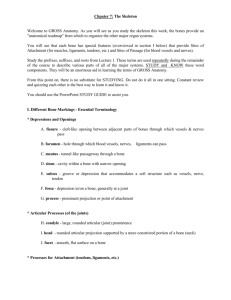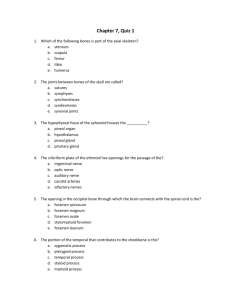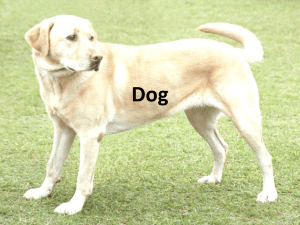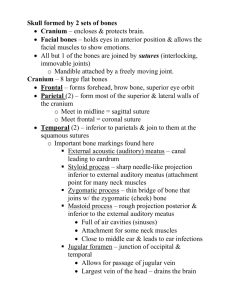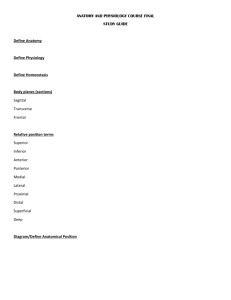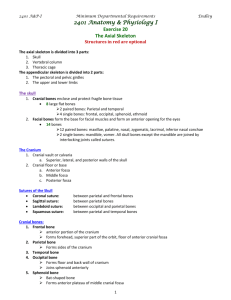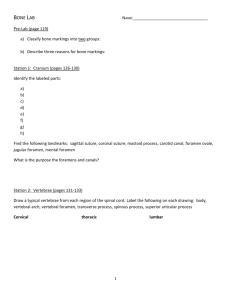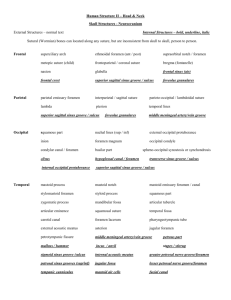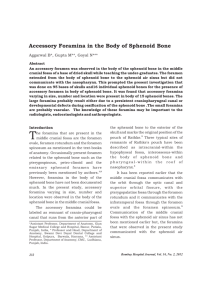Ch07a Axial Skeleton
advertisement
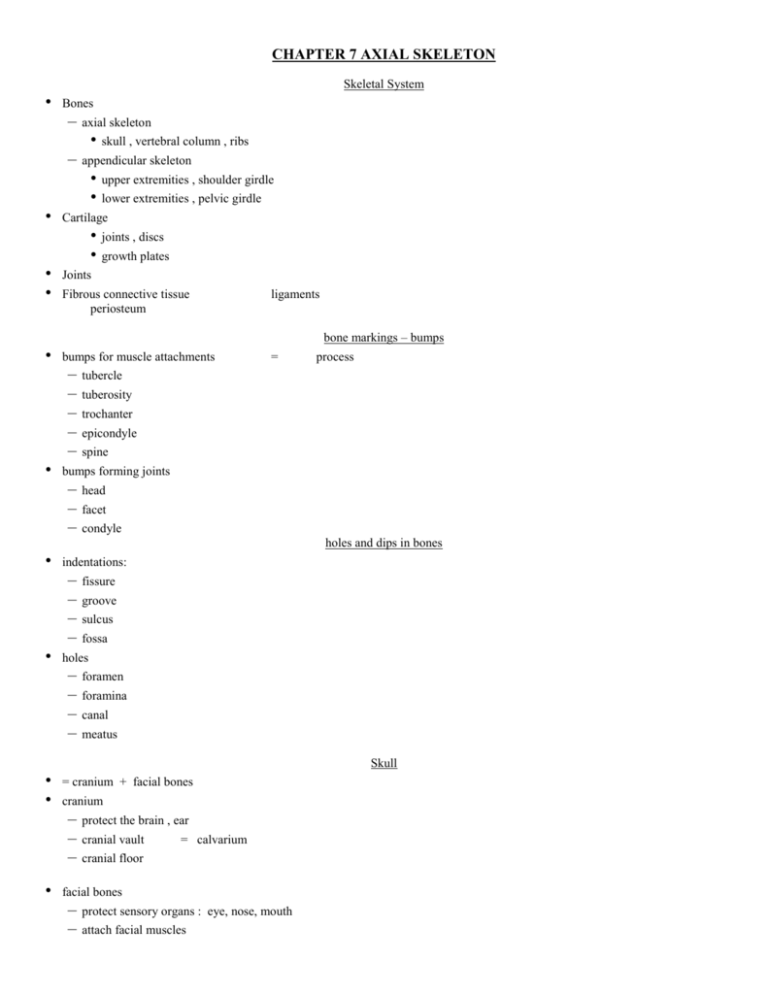
CHAPTER 7 AXIAL SKELETON Skeletal System • • • • Bones – axial skeleton – appendicular skeleton • skull , vertebral column , ribs • upper extremities , shoulder girdle • lower extremities , pelvic girdle Cartilage • joints , discs • growth plates Joints Fibrous connective tissue periosteum ligaments bumps for muscle attachments = bone markings – bumps • • – – – – – process tubercle tuberosity trochanter epicondyle spine bumps forming joints – – – head facet condyle holes and dips in bones • • indentations: – – – – fissure groove sulcus fossa holes – – – – foramen foramina canal meatus Skull • • • = cranium + facial bones cranium – – – protect the brain , ear cranial vault = calvarium cranial floor facial bones – – protect sensory organs : eye, nose, mouth attach facial muscles cranial bones • • • • • • frontal parietal temporal occipital sphenoid ethmoid facial bones • • • • • • • • mandible maxilla zygomatic nasal lacrimal vomer palatine inferior nasal conchae temporal bone • • • • squamous portion zygomatic portion – – zygomatic process mandibular fossa mastoid portion – – – – mastoid process styloid process external acoustic meatus stylomastoid foramen petrous portion – – inner ear ; internal acoustic meatus carotid canal occipital bone • • • • • • • floor, posterior wall of cranial cavity occipital condyles joint with vertebral column foramen magnum passage for spinal cord basilar portion (clivus) hypoglossal canal external occipital protuberance superior , inferior nuchal lines sphenoid bone • • • • • • greater wing lesser wing pterygoid processes - medial, lateral sella turcica – – dorsum sellae ; tuberculum sellae hypophyseal fossa optic canal superior orbital fissure • • • foramen ovale foramen spinosum foramen rotundum ethmoid bone • • • • • • lateral mass ; orbital plate perpendicular plate superior nasal concha middle nasal concha cribriform plate – olfactory foramina crista galli mandible • • • • • body ramus angle mandibular condyle coronoid process mental foramen mandibular foramen features of skull bones • occiptal bone floor, posterior wall of cranial cavity articulates with C1 parietal protect brain frontal forehead ; roof of orbits; anterior floor frontal sinuses • temporal protect ear articulate with mandible muscles for jaw , neck mastoid sinus • sphenoid articulates with every other cranial bone unites cranial and facial bones houses pituitary gland (sella turcica) optic canal features of skull bones • ethmoid medial wall of orbit foramina for olfactory nerves (cribiform) nasal septum (perpendicular plate) attach dura, stabilize brain (crista galli) • maxilla floor of orbit ; part of hard palate teeth maxillary sinuses zygomatic lateral wall of orbit ; “cheek” bone mandible teeth ; jaw articulate with temporal bone conchae increase area of nasal cavity • • • • • sutures • • • • • sagittal betw parietal bones coronal parietal – frontal bones lambdoid parietal – occipital bones squamous parietal – temporal bones occipitomastoid occiput - temporal orbit • • • • • • • • • frontal bone zygomatic maxilla ethmoid sphenoid lacrimal optic canal superior orbital fissure inferior orbital fissure compund structures • zygomatic arch zygomatic bone zygomatic process of temporal • nasal septum perpendicular plate of ethmoid vomer • palate palatine bone palatine process of maxilla • temporal fossa • orbit holes in front • • • • • • • • • • • • – – – optic canal sphenoid optic nerve CN II superior orbital fissure sphenoid inferior orbital fissure several bones CN V supraorbital foramen frontal CN V infraorbital foramen maxilla CN V mental foramen mandible CN V facial – – – above: – olfactory foramina cribriform plate CN I holes down under foramen magnum occiput spinal cord carotid canal temporal int carotid artery jugular foramen temporal int. jugular vein ; CN’s stylomastoid foramen temporal foramen ovale sphenoid foramen spinosum sphenoid hypoglossal canal occiput foramen rotundum occiput CN V CN V foramen lacerum incisive fossa maxilla sinuses • • paranasal sinuses – – – – air filled extensions of nasal cavity make skull lighter frontal ethmoid maxillary sphenoid mastoid sinus no connection to nasal functions of vertebral column • • • • • weight bearing support head muscles for trunk and head protect spinal cord passage for spinal nerve vertebral terms • • • • vertebra 1 bone vertebral column all bones spinal column = vertebral column spine = vertebral column • spinal cord nervous system extension from brain • naming C1-7 ; T1-12 ; L1-5 vertebra • • • • • vertebral body vertebral foramen = vertebral canal • protects spinal cord vertebral arch – – lamina pedicle processes • • • spinous process SP transverse process TP articular processes = facets intervertebral foramina between vertebra , laterally spinal nerves Cervical spine • • • • • • • C1 – C7 small vertebral body bifid SP transverse foramen atlas = C1 axis = C2 vertebral prominens hole in transverse process vertebral artery and vein = spinous of C7 atlas • • • • • • C1 no vertebral body lateral mass anterior and posterior arch joint with occipital condyles • flex and extend head vertebral foramen - foramen magnum “yes” axis • • • C2 dens = odontoid process atlas rotates around dens • rotations of head and neck “no” thoracic vertebra • • • • T1 – T12 attach ribs attach muscles support and move spine long SP - angled down lumbar spine • • • • L1 – L5 thick vertebral body + straight SP support most body weight attach muscles of support and movement sacrum and coccyx • • sacrum – – – – – – – fused S1 – S5 sacral promontory top surface (meets L5) ala sacral foramina sacral crest sacral canal sacral hiatus coccyx Intervertebral disc • • • IVD same # as vertebra above “cushion” between vertebrae nucleus pulposus gel / water hydraulic pressure • annulus fibrosus fibrocartilage contains NP • “herniated disc” vertebral curves • • • lordosis anterior curve C/S L/S kyphosis posterior curve T/S Sacrum abnormal – – – – hyperlordosis increased lordosis hypolordosis decreased lordosis hyperkyphosis increased kyphosis (T/S) scoliosis lateral curvature thoracic cage • • • sternum – – – body manubrium – jugular notch – sternal angle ( = sternal notch) xiphoid process ribs functions : protect heart and lungs aid in respiration attach upper extremity muscles for trunk, UE, and neck ribs • • • • 7 true ribs attach to sternum 3 false ribs attach to rib 7 2 floating ribs don’t attach anteriorly costal cartilage ribs are cartilage anteriorly
